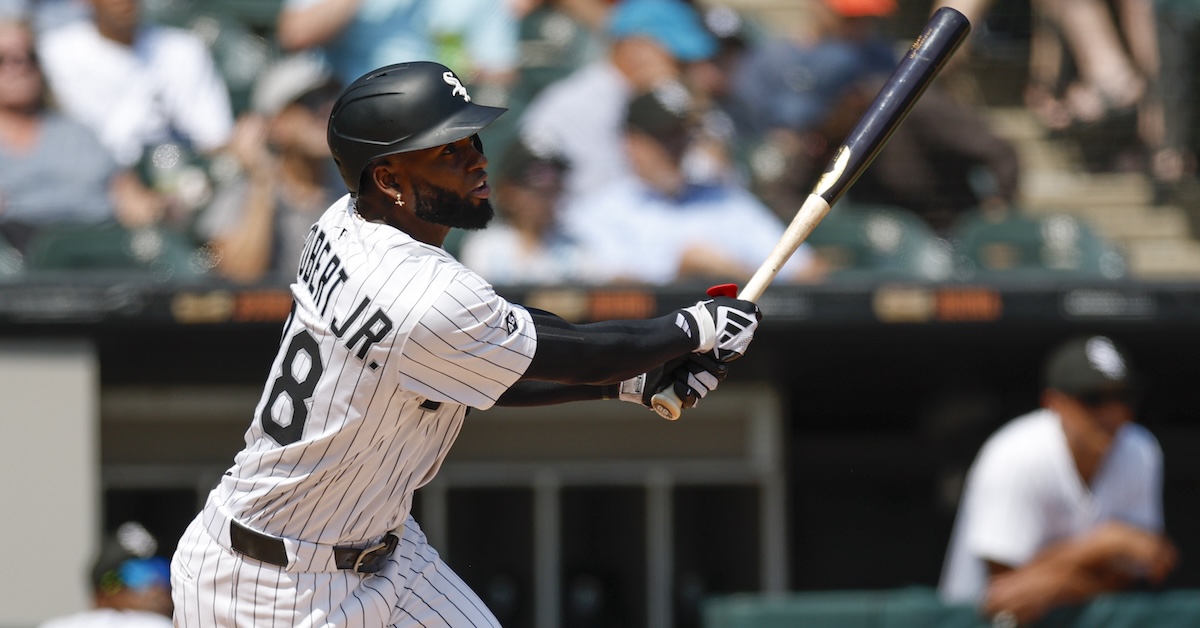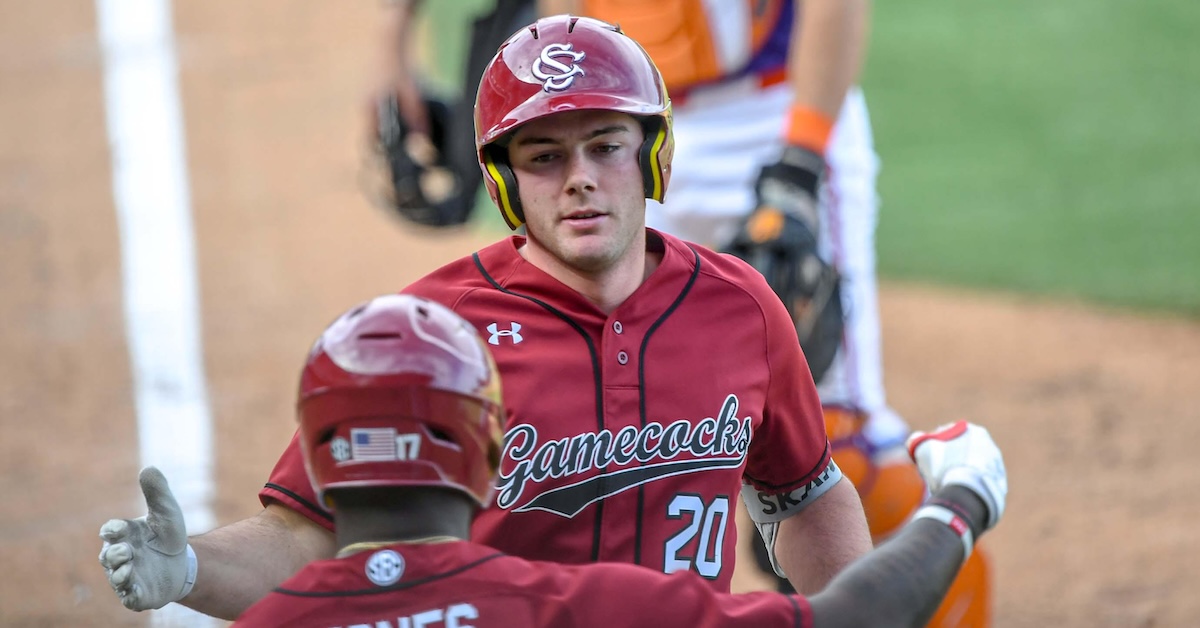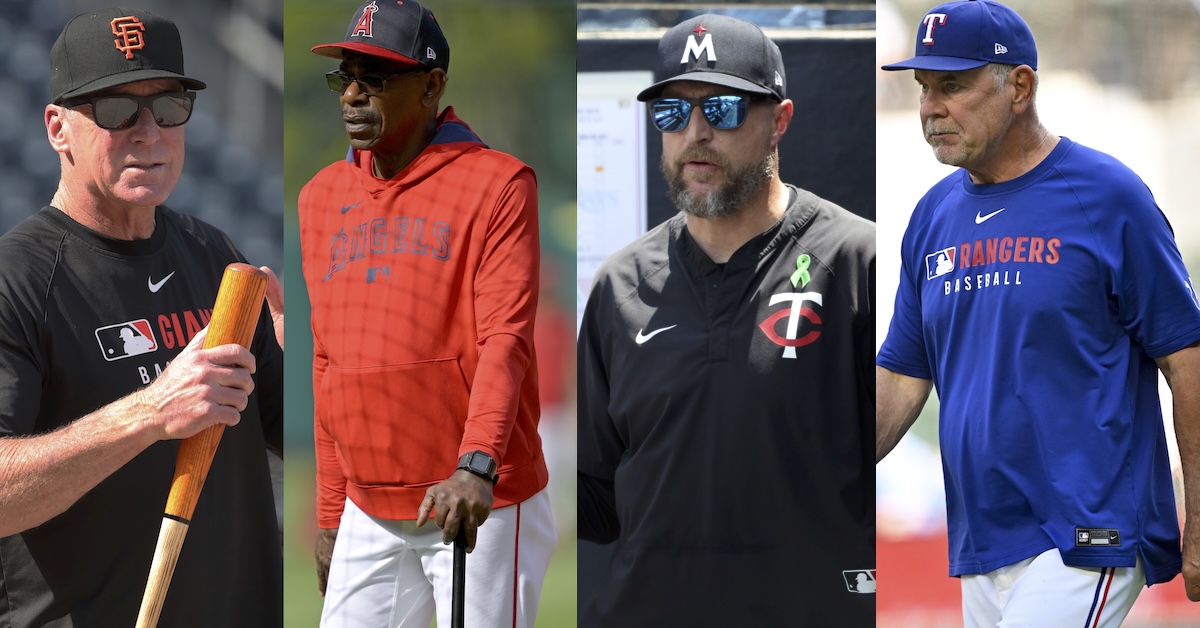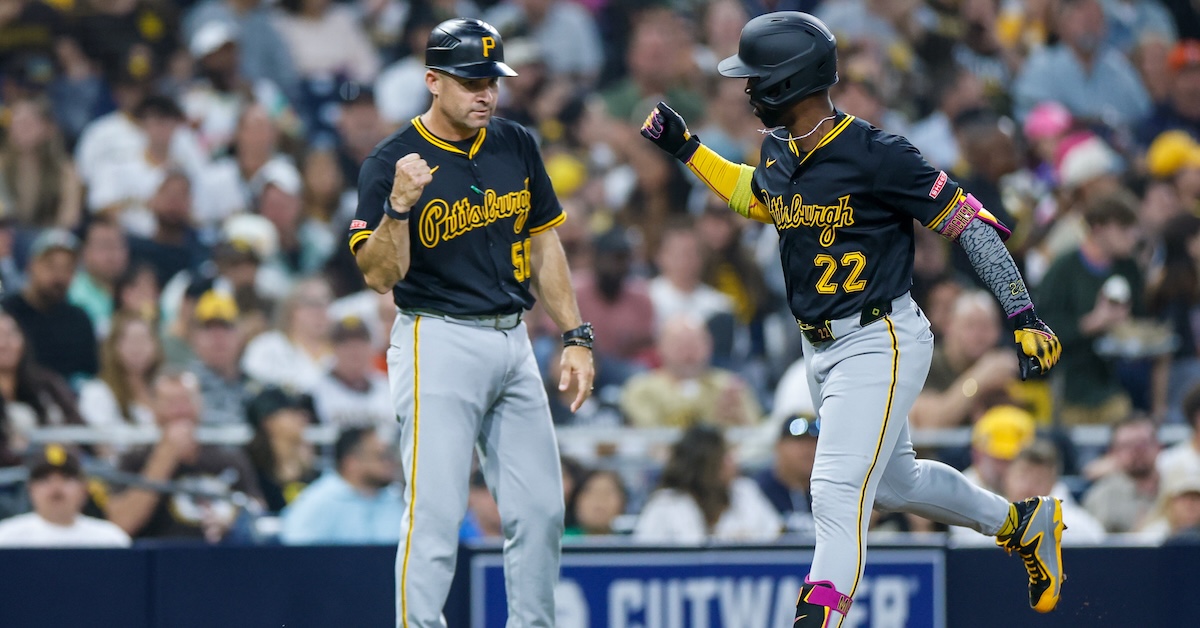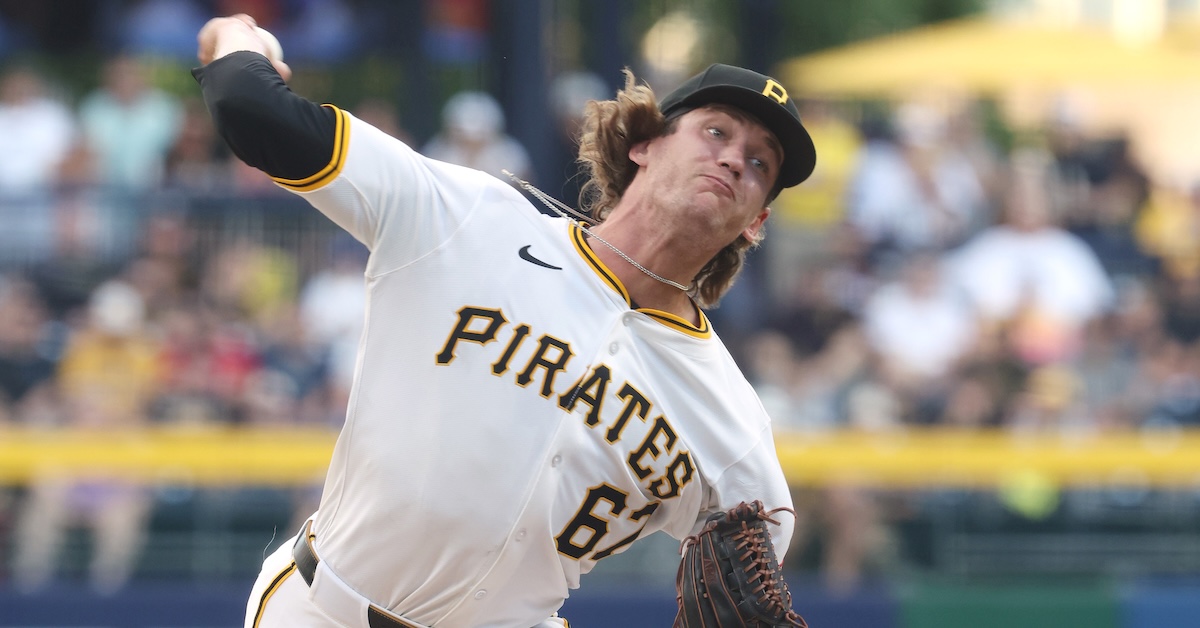A Player’s View piece that ran here at FG a month ago was one of my favorites to put together all season. Entertaining as well as informative — good anecdotes were in abundance — it was self-explanatorily titled: Pitchers Weigh In On Their Catch Play Partners (Some Are Nasty). As evidenced within, a casual tossing of baseballs back and forth is far from what is actually happening.
Last weekend, I learned that Bubba Chandler has scratched Paul Skenes from his partners list.
“We’ve trained together the last two off-seasons, and we’ve played catch,” the Pittsburgh Pirates rookie told me. “I don’t want to give him his flowers, but my vision isn’t great, and he’s a guy who throws hard and his pitches move a lot. The eyes can’t really keep up with the ball. And then you’re throwing in 50-degree weather with clouds and a light mist — or maybe it’s a super-bright day — and you can’t see it. And he’s just freaking ripping it. I’ll never play catch with him again.
“I got friggin’ popped in Baton Rouge this year, and that was actually indoors,” continued Chandler. “He threw his stupid sinker, and it didn’t sink. It rose off the top of my glove, right to my shoulder. So yeah, I’ll never do it again.”
As is common for starters, Chandler typically does his in-season catch play with a bullpen catcher — a breed whose job requirements make catching most anyone a comparable piece of cake. But what about other pitchers? Is Chandler an easy partner, or someone best to avoid?
“Throughout the week I’m an easy catch-play, but the day before I pitch, I let it eat a little bit,” said the righty, whose heater flirts with triple digits. “It’s not a lot of volume, maybe just 20-25 throws, but that’s the day I throw hard and it moves pretty good. I assume guys don’t want to play catch with me on that day.”
Chandler, who has made three relief appearances since being called up in late August, is scheduled to make his first MLB start this afternoon.
———
RANDOM HITTER-PITCHER MATCHUPS
Eddie Mathews went 18 for 36 against Moe Drabowsky.
Carl Yastrzemski went 10 for 16 against Bill Gogolewski.
Greg Luzinski went 15 for 34 against Andy Messersmith.
Bill Mazeroski went 20 for 50 against Don Nottebart.
Ted Kluszewski went 23 for 50 against Warren Hacker.
———
Pete Crow-Armstrong was a high-profile prospect when I approached him on the back fields of the Chicago Cubs spring training complex in 2023. The young outfielder’s thoughts on his development as a hitter is what I were after, and one of the things he said in our relatively brief conversation stood out: “I feel like you’re probably going to ask me about the power.”
Two-and a-half years later, PCA, as he is affectionally called by Cubs fans, has 28 home runs and a .496 slugging percentage in his second full season in the big leagues. With that in mind, I reminded him of what he had said to me in Mesa. Looking back, was he self-conscious, or perhaps a little defensive, about his power potential?
“That was kind of the topic of conversation in my offensive game at the time,’ Crow-Armstrong told me at Wrigley Filed on Friday. “I was very prepared to be approached about the lack of power. What everybody always wanted to talk about was how my hitting was like… I think that everybody knew that I could play defense, but everybody was always more skeptical about my bat. Rightfully so. So, I was always prepared to answer questions about what was lacking in my offensive game.”
Crow-Armstrong had also told me in our back-fields exchange that his power has “always been there.” Does he have more now than he did in the minors?
“I feel like I’ve developed into my power,” he said to that question. “I have the same wiry strength, but you’re seeing the natural evolution of a growing human being that’s gotten better at what he does.”
———
A quiz:
Nolan Ryan (at age 44, in 1991) is the oldest MLB pitcher to throw a no-hitter, while Amos Rusie (at age 20, in 1891) is the youngest. The next four youngest pitchers threw theirs between 1901-1912.
Who is the youngest pitcher to throw a no-hitter in the past 100 seasons? (A hint: he won a Cy Young award and three World Series rings.)
———
NEWS NOTES
Rich Hinton, a left-hander who appeared in 116 games while playing for five teams from 1971-1979, died recently at age 78 (per Newsweek). Pitching primarily with the Chicago White Sox, Hinton was credited with nine wins and three saves.
Davey Johnson died yesterday at age 82. A highly-successful manager following his playing days, the second baseman made four All-Star teams and won three Gold Gloves while strapping on the cleats from 1965-1978. Primarily a Baltimore Oriole, Johnson hit 43 home runs for the Atlanta Braves in 1973.
———
The answer to the quiz is Vida Blue, who threw a no-hitter in September 1970, 55 days after his 21st birthday. If you guessed Wilson Alvarez, his August 1991 no-hitter came 140 days after his 21st birthday.
———
Cleveland’s Stephen Vogt was asked about Fenway Park’s outfield dimensions prior to this past Monday’s holiday matinee in Boston, and as do many managers, he pointed not to the Green Monster, but rather to the large expanse on the other side of the diamond.
“It’s like a center field in right field,” Vogt told a cadre of reporters. “There are so many cool nooks and crannies. That’s why I love baseball. Not one field is the same. But yeah, we’ve got to get our work in. Even though it’s a day game, we’ve got to come out get looks and understand what we’re dealing with.”
I had a question for Vogt regarding the opponents the Guardians have had to deal with. Which is the best team you’ve played so far this season?
“That’s a good question,” Vogt replied. “I’m stumped here. The Dodgers are obviously… when we played the Dodgers it was a really good team. But I have so much respect for everybody. There are so many really, really good teams out there. So yeah. I don’t know.”
The Guardians lost two of three games when they hosted the Dodgers in late May.
———
FOREIGN AFFAIRS
Munetaka Murakami has 18 home runs and a 246 wRC+ over 152 plate appearances in his return to action following an oblique injury (which was preceded by elbow surgery last winter). The 25-year-old Tokyo Yakult Swallows slugger is considered a strong candidate to be posted following the NPB season.
Sung-mun Song is slashing .314/.389/.528 with 24 home runs and a 149 wRC+ over 581 plate appearances with the KBO’s Kiwoom Heroes. The recently-turned-29-year-old third baseman/second baseman has reportedly asked to be posted following this season.
Cody Ponce broke the KBO’s single-season strikeout record this past week. The 31-year-old Hanwha Eagles right-hander has fanned 228 batters while going 16-0 with a 1.76 ERA over 163-and-two-thirds innings. Ponce went 1-7 with a 5.86 ERA pitching for the Pittsburgh Pirates in 2020-2021.
Eric Stout is 7-4 with a 2.45 ERA over 113-and-two-thirds innings for the Chinese Professional Baseball League’s TSG Hawks. The 32-year-old left-hander out of Butler University appeared in 23 games for three MLB teams, mostly the Pirates, from 2018-2022.
———
A random obscure former player snapshot:
Gene Hiser’s lone big-league home run was especially memorable. Batting with two out in the bottom of the ninth inning and the Chicago Cubs trailing the New York Mets by a count of 3-2, the outfielder cleared the right field fence at Wrigley Field to send the game to extras. The home team then walked off the June 19, 1973 contest in the 10th on a Jose Cardenal single that plated Billy Williams.
The rest of Hiser’s career wasn’t much to write home about. All told, the University of Maryland product played in 206 games for the Cubs from 1971-1975, logging 53 hits and a 45 wRC+. He did have success against a Hall of Famer. Hiser went 3-for-8 against St. Louis Cardinals legend Bob Gibson.
———
Eric Binder plays a key role in Cleveland’s pitching-development program, as well as in the organization’s draft decisions. I recently asked the assistant general manager for his thoughts on a pair of 19-year-old pitchers whom the Guardians selected in last year’s amateur draft.
“A young right-hander starter who recently transitioned from [the Arizona Complex League] to Lynchburg,” Binder said of Joey Oakie, who was selected 84th-overall out of Ankeny, Iowa’s Centennial High School. “High velocity. A fastball that we’re all excited about. How his delivery operates and with the profiles we’re seeing out of hand, he’s creating an interesting demand on the hitter with how that gets pieced together.
“Another guy from last year’s draft class,” Binder said of Braylon Doughty, who was taken 36th-overall out of Temecula, California’s Chaparral High School. “He broke with the Lynchburg team out of spring training. An incredible athlete, and you see that translate to his delivery. Some natural feel to create a lot of different shapes, with plus underlying spin traits. A natural strike thrower. We’re really excited to see him progress with us, as well.”
Doughty — seventh on our updated Guardians list, with a 45+ — has a 3.48 ERA, a 2.84 FIP, and a 27.3% strikeout rate over 85-and-a-third innings with Lynchburg. Oakie — 23rd on our list, with a 40+ FV — has a 5.31 ERA, a 4.59 FIP, and a 26.8% strikeout rate over 54-and-a-thirds between the AZL and Lynchburg. Topping out at 99 mph, Oakie has fanned 22 batters and allowed just one hit over nine-and-two-thirds innings in his last two outings.
———
FARM NOTES
Kendall George has a most-in-the-minors 101 stolen bases (in 125 attempts) to go with a .295/.409/.370 slash line, three home runs, and a 131 wRC+ over 514 plate appearances for the High-A Great Lakes Loons. No. 25 on our updated Los Angeles Dodgers Top Prospect list with a 40 FV, the 20-year-old outfielder was drafted 36th overall last year out of Humble, Texas’s Atascocita High School.
Gabriel Gonzalez is slashing .329/.397/.508 with 13 home runs and a 148 wRC+ over 510 plate appearances across three levels. Currently with the Triple-A St. Paul Saints, the 21-year-old outfielder was acquired by the Minnesota Twins from the Seattle Mariners as part of the January 2024 Jorge Polanco trade. Gonzalez is No. 9 in our updated Twins rankings, with a 45 FV.
Micah Ashman has a 1.95 ERA, a 1.55 FIP, and a 33.5% strikeout rate over 55-and-a-third innings between High-A and Double-A. An 11th-round pick last year out of the University of Utah, the 23-year-old left-hander was acquired by the Baltimore Orioles from the Detroit Tigers in exchange for Charlie Morton at this summer’s trade deadline.
The Midwest League’s West Michigan Whitecaps have the best record in the minors at 90-39. The Detroit Tigers’ High-A affiliate has a plus-289 run differential.
The Dayton Dragons (High-A Cincinnati Reds) won 15 consecutive games before losing to the Lansing Lugnuts 5-4 on Thursday night. The Dragons have the Midwest League’s worst record at 51-76, and a minus-114 run differential.
———
Kenya Huggins was caught by surprise when he learned that he’d been dealt from the Reds to the Athletics at this summer’s trade deadline. A fourth-round pick by Cincinnati in 2002 out of Chipola Junior College, the 22-year-old right-hander was eating a bowl of cereal when he received the news.
“It’s the craziest experience I’ve ever had,” said Huggins, who has been with High-A Lansing since changing organizations. “It’s funny, we were actually playing here [at West Michigan]. I had just gotten promoted to Dayton, and I was going to be pitching the next day. My manager pulled me into the office and said, ‘Hey, I need to talk to you.’ I was like, ‘Cool, let’s go chat.’ I was eating a bowl of Cap’n Crunch. Had just come in from shagging. Just a regular day. No problem.
“So, I go in the office,” continued Huggins. “He told me, ‘Hey, I wanted to let you know before you look at your phone that you’ve been traded for a big-leaguer. Miguel Andujar is going to the Reds and you’ll be heading to the Athletics.’ At that moment, I had no words. All I could say was, ‘I appreciate you.’”
The hard-throwing native of New Orleans appreciates his breakfast cereal, as well. I learned as much when I asked if he finished the bowl of Cap’n Crunch.
“Yeah, I finished it,” Huggins replied with a smile. “I drank the milk, took in the information, and that was that.”
Huggins has a 3.81 ERA and a 3.80 FIP over 78 innings on the season. He is No. 13 with a 40+ FV in our latest A’s prospect rankings.
———
LINKS YOU’LL LIKE
At NBC News, David K. Li looked at how the Women’s Professional Baseball League aims to make the most significant impact on women’s baseball since the All-American Girls Professional Baseball League, which operated from 1943 to 1954.
Former Tampa Bay Rays right-hander Yonny Chirinos is pitching for the KBO’s LG Twins this season. Jee-ho Yoo wrote about him for Yonhap News Agency.
MLB.com’s Matthew Leach wrote about Minnesota Twins prospect Kala’i Rosario, who has 25 home runs and 25 steals for Double-A Wichita Wind Surge.
MLB.com’s Sarah Wexler introduced us to a prolific songwriter who has recorded hundreds of baseball tunes, many of them about specific MLB players.
Texas Rangers manager Bruce Bochy is 70 years old and in the last year of his contract. Is this his swan song? Barry Bloom delved into the question at Sportico.
———
RANDOM FACTS AND STATS
Milwaukee’s Quinn Priester is 11-0 with a 2.79 ERA since May 30. The Brewers have won all 17 games he’s appeared in since that time.
A good note from ESPN’s Jesse Rogers on Friday afternoon: “The wind is blowing out at Wrigley for just the 16th time in 68 games this season. Teams have combined to average 12.9 runs per game when it blows out, compared to seven when it blows in.
Luis Arraez recorded his 1,000th career hit earlier this week. The three-time batting champ currently has 1,005 hits, including 221 extra-base hits, as well as 224 walks and 211 strikeouts.
Freddie Freeman has 938 extra-base hits, the most among active players. He is tied with Hall of Famer Eddie Mathews for 58th all-time in that category.
Rafael Devers has 16 home runs and a 136 wRC+ in 70 games with the San Francisco Giants. He had 15 home runs and a 144 wRC+ in 73 games with the Boston Red Sox prior to being traded in June.
Ichiro Suzuki and Troy Tulowitzki went a combined 0-for-28 against Ryan Vogelsong. Omar Infante and Billy Hamilton went a combined 13-for-19 against Vogelsong.
On today’s date in 1971, Mickey Lolich went the distance to run his record to 23-10 as the Detoit Tigers blanked the Washington Senators 3-0 at RFK Stadium. Lolich finished the season 25-14 with a 2.92 ERA over 376 innings. He threw complete games in 29 of his 45 starts.
The Boston Braves swept a doubleheader from the Brooklyn Dodgers on today’s date in 1948, winning by scores of 2-1 and 4-0. Warren Spahn went the distance in the 14-inning opener, then Johnny Sain threw a complete game of his own while throwing half as many frames. The nightcap was called on account of darkness after the Dodgers batted in the top of the seventh.
Players born on today’s date include John Pawlowski, a right-hander who made eight relief appearances for the Chicago White Sox across the 1987-1988 seasons. A longtime college coach following his playing career, Pawlowski was on the winning end of his lone decision, the W coming courtesy of a Carlton Fisk walk-off home run against Oakland’s Eric Plunk.
Also born on today’s date was Stan Pawloski, an infielder whose big-league career comprised two games and one hit in eight at-bats for the Cleveland Indians in 1955. The Wanamie, Pennsylvania native spent nine seasons on the farm, the first of them with the 1949 Stroudsburg Poconos, a team that went 101-36 before going on to top the Peekskill Highlanders in the North Atlantic League championship series.
